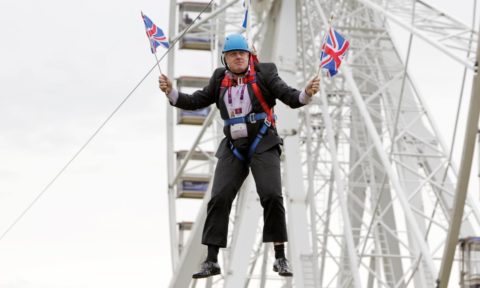Viva La Dirt League
Published 14 Dec 2020Rowan thinks its a good idea to play X-mas music in the store for the entire Christmas period … and the staff aren’t happy
Get a 12% discount off all SteelSeries products by using our code
VLDL12. Not only do you get a special discount but we make 8% on all sales! So get a great deal and help support us!
Link: https://bit.ly/31ltYT2
Code:VLDL12WATCH MORE SKITS HERE: https://bit.ly/34oAolt
SUPPORT ON PATREON: https://bit.ly/36Hg7ZY
DISCORD: http://discord.gg/VLDL
TWITTER: https://bit.ly/36R84dt
INSTAGRAM: https://bit.ly/2EoniKD———————————- TWITCH ——————————-
https://www.twitch.tv/team/vldl
———————————– MERCH——————————–
Merchandise: https://bit.ly/2DQm3GX
Songs: https://bit.ly/2OBeB4OBUSINESS ENQUIRIES – vivaladirtleague@gmail.com
Postal Address:
Viva La Dirt League
PO Box 41378
Mt Roskill
Auckland 1440
NEW ZEALAND
December 21, 2020
Horrible Christmas music in retail stores – X-mas Music
Boris “Ebenezer” Johnson cancels Christmas
What is it with British PMs and political U-turns?
So Christmas is cancelled. The neo-Cromwellian edict has been issued. The thing that Boris Johnson said would be “inhuman” just a few days ago has now been done. For the first time in centuries people in vast swathes of England – London and the South East – will be forbidden by law from celebrating Christmas together. The government’s promise of five days’ relief from the stifling, atomising, soul-destroying lockdown of everyday life has been snatched away from us. It’s too risky, the experts say; the disease will spread and cause great harm. You know what else will cause great harm? This cruel, disproportionate cancellation of Christmas; this decree against family festivities and human engagement.
This evening Boris Johnson executed the most disturbing u-turn of his premiership: he scrapped the planned relaxation of lockdown rules for Christmas. He commanded that London and the South East will be propelled into Tier 4, yet another Kafkaesque category of authoritarianism dreamt up by our increasingly technocratic rulers. This means no household mixing, including on Christmas Day. That’s millions of planned get-togethers, family celebrations, cancelled with the swipe of a bureaucrat’s pen. Other areas outside of London are luckier: Boris has graciously granted them one day off from the lockdown rules, on Christmas Day, when they may mix with people from other households. They will no doubt give praise to their benevolent protectors for such festive if fleeting charity.
There is much that is disturbing about Boris’s decree. It is being justified on the basis that a new strain of Covid-19 is spreading in the South East and seems more contagious than earlier strains. That is certainly something we should be aware of. But Boris also declared that there is no evidence that this new strain has led to “increased mortality”. So what is going on here? Surely before enacting the drastic, almost unprecedented measure of preventing millions of people from celebrating Christmas together the government should offer up clearer evidence of the significant social harms that would allegedly spring from such celebrations? The political and media elites go on and on about “evidence-based policy”, except when it comes to locking people down. Then it’s all “Yeh, go ahead, better safe than sorry”.
Lee Metford MkI: Great Britain’s First Magazine Rifle
Forgotten Weapons
Published 14 Sep 2020http://www.patreon.com/ForgottenWeapons
https://www.floatplane.com/channel/Fo…
Cool Forgotten Weapons merch! http://shop.bbtv.com/collections/forg…
The British went into the 1880s with plans to adopt the Enfield-Martini as its new rifle, a single shot Martini-action rifle with essentially a sidesaddle of ready-access cartridges on the side of the receiver. It would be chambered for a new .402 caliber black powder cartridge. However, the Small Arms Committee begin looking into the possibility of a magazine rifle instead, and trials of 40+ different systems found three worth considering: a Lee rifle with a box magazine, a Lee rifle with a Bethel Burton magazine, and the Owen Jones rifle. As these trials were concluding, the discovery of smokeless powder threw a wrench in the plans.
After study of the Swiss 7.5×53.5mm cartridge, the British opted to develop a small bore .30 caliber round themselves, which would be the .303 British. This round, originally loaded with compressed black powder before the use of cordite, rendered the plans for the .402 caliber Enfield Martini obsolete. What would have been a justifiable territorial and reserve rifle alongside a .402 magazine rifle was now an orphan. With the new rifle in .303 caliber, a .402 single shot Martini was just an added logistical overhead. Instead, existing Martini rifles would eventually be converted to .303 British.
At any rate, the Lee rifle and magazine were chosen as ideal, and in 1888 a batch was made for field trials across the British Empire. Widely positive reports led to its formal adoption and the beginning of production in 1889 as the Magazine Rifle MkI – later retroactively renamed the Lee Metford MkI and colloquially known as the Long Lee. The example we have today has two very rare original features; an intact manual safety and Lewes pattern sights. Both of these would be quickly removed or replaced in service, and a Mk I* and MkII pattern followed shortly after the adoption of the MkI.
Contact:
Forgotten Weapons
6281 N. Oracle #36270
Tucson, AZ 85740
QotD: The evolving style of John Coltrane
No jazz musician incarnates the legend of late style more than the saxophonist John Coltrane. His early style is undistinguished; he was a bluesy sideman whose grasp of the instrument falls short of the reach of his ear. His middle style, stertorous and ambitious, began in his mid-1950s stint with Miles Davis’s quintet. Coltrane in this period is still less melodious than Hank Mobley and less witty than Sonny Rollins, but his chops are catching up with his ear. Only Johnny Griffin has fleeter fingers and only Rollins can beat him for persistence. Coltrane thinks aloud and never stops thinking; he is the perfect foil for Davis, who is also ironic and intellectual, also latent with eroticism and violence, but who never shows his working, only the finished idea. Coltrane’s sound waves are square and heavy, metallic and dark like lead. He is both implacable and lazy, like a bull elephant: You never know where the charge will take him, only that — as he himself admitted to Davis — once he gets going, he doesn’t know how to stop.
Coltrane’s late style emerged in his 1960s quartets. Now leading and writing for his own group, and newly clean of drink and drugs, he was finally able to pursue his vision and the possibilities of the music to the limits of form and expression — and ultimately beyond both. The further he went, the more ambitious and less accessible the music became, until it was incomprehensible to almost all of his audience and even to some of his closest collaborators. In the logic of modernism, further means better. But “faster” and “louder” aren’t necessarily better, so why should “further” be the supreme critical value? To judge Coltrane’s late-style art is, in an important sense, to judge modernism itself, and especially American modernism.
Dominic Green, “John Coltrane and the End of Jazz”, The Weekly Standard, 2018-08-26.






